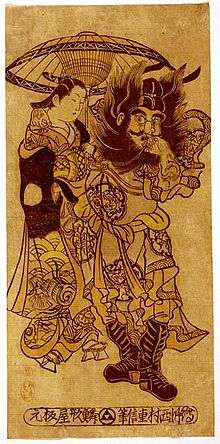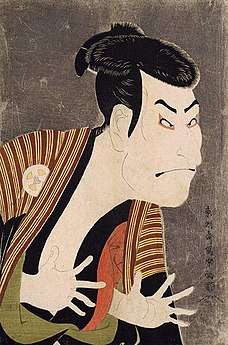Urushi-e

Urushi-e (漆絵 "lacquer picture[s]") refers to three different types of Japanese artworks:[2][3]
- Woodblock prints overpainted with a mixture of ink and animal glue to produce shiny areas resembling lacquer.
- Painting in lacquer on three-dimensional lacquer objects.
- Paintings painted with actual lacquer on paper or occasionally silk.
Prints
Urushi-e woodblock prints were made using thick, dark black lines, and were sometimes hand-colored. The ink was mixed with an animal-based glue called nikawa, which thickened it and gave it a lustrous shine, said to resemble lacquer. Most often, this was used not in creating the entire print, but only in enhancing a particular element, such as an obi or a figure's hair, to give it shine and make the image more luxurious overall.
Prints which include urushi-e elements are likely to also feature the use of mica, metal dusts, and other elements which enhanced the appearance, quality and value of the works. The technique was most popular in the early 18th century, and can be seen in works by Okumura Masanobu, Torii Kiyomasu and Torii Kiyonobu I, among many others.
Paintings
In painting, the term refers to the use of colored lacquers, produced by mixing pigments with clear lacquer. The use of colored lacquer for painting goes back to the prehistoric Jōmon period, and became especially popular in the Nara period (8th century), when a great many works were made using red lacquer against a black background. Until the 19th century, however, the use of natural pigments restricted the colors accessible to artists to red, black, yellow, green, and light brown.
Artist Shibata Zeshin (1807-1891) is particularly famous for his innovations in this regard, and was perhaps the first to use lacquer not just as a decorative element (in painting boxes, furniture, and pottery) but as a medium for painted scrolls. Zeshin experimented extensively with various substances, which he mixed with lacquer to create a variety of effects, including simulating the appearance of various metals (iron, gold, bronze, copper), and imitating the appearance and texture of Western oil painting.
See also
References
| Wikimedia Commons has media related to Urushi-e. |
- ↑ "Young Lovers by Mount Fuji". Asia. Victoria and Albert Museum. Retrieved 2007-12-12.
- ↑ Doshin, Sato, Shibata Zeshin: From Lacquer Arts to Painting, Nezu Museum, Tokyo, 2012, p. IX
- ↑ Lane, Richard, Images from the Floating World, the Japanese Print, Dorset Press, New York, p. 341

